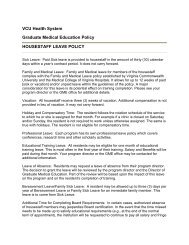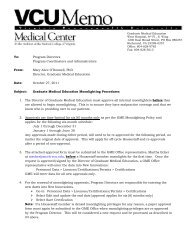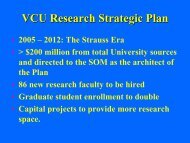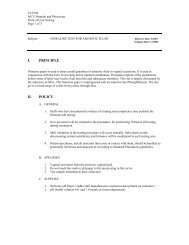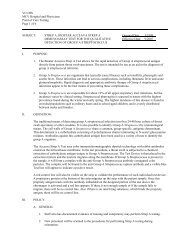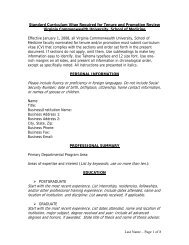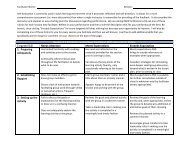There is a great deal <strong>of</strong> commentary online aboutwhat these factors mean in terms <strong>of</strong> how youinteract with other people or ideas. There are manyquestionnaires available online that will provide aMyers-Briggs score. Searching for the phrase “freeMyers-Briggs” should find a few. Much <strong>of</strong> thedevelopment around these personality types hasbeen done in North America and Western Europe,so some <strong>of</strong> what you read in these descriptions(especially in the areas <strong>of</strong> introversion andextroversion—one’s openness to other people orpreference for spending time alone), will be writtenwith cultural assumptions that may be differentfrom those in your own region.A popular way to understand your on-the-jobstrengths and weaknesses is to seek feedbackfrom those around you, including those above youin rank, your peers, and people you admire. Youmay be surprised to find that areas you consideryour special strengths are viewed by others asyour areas <strong>of</strong> weakness and vice versa. Feedbackfrom others can help you recognize and see pastyour blind spots.Creating YourVision as a LeaderMost people understand that the president <strong>of</strong> auniversity or the head <strong>of</strong> a large institute musthave a vision for what he or she wants to accomplish.But what about someone running a lab, orsomeone working on one project within a largerlaboratory? Even in a very small working group—one researcher and a technician—if there is noclear vision <strong>of</strong> what drives the work and what itsgoal is, someone may head <strong>of</strong>f in his or her owndirection, wasting time and potentially generatingill will.Without a clear shared goal, small disagreementsand normal human differences may becomemagnified as individuals’ own preferences maycome to overshadow what is really important fordriving the work forward. Developing a vision foreveryone in the lab to share does not limit innovation.Instead, it provides a foundation for creativityfrom which new directions may be taken. If youhave many people working under you, a sharedvision may help them better understand how youset priorities.How to Create a Mission StatementWriting a formal mission statement can provideyou with a cornerstone for building the vision foryour lab. This statement describes the kind <strong>of</strong>research you want to do, the motivation for yourresearch, and the kind <strong>of</strong> atmosphere in whichyou want to work. It should take into considerationthe history and current challenges <strong>of</strong> your lab andwhat you want to accomplish in the short and longterm, with an eye to your future work.If your position is one <strong>of</strong> higher responsibility, yourvision and mission will be oriented toward theachievements <strong>of</strong> a department and institution as awhole. The exercise <strong>of</strong> writing down a mission anda vision may seem artificial, but it can be usefulto capture “the big picture” and to refer to it nowand then to see if you are spending your time andeffort in ways consistent with movingyou closer to your long-term intentions.As you develop your mission statement, keep inmind the following points:n Decide what values you want for your lab (e.g.,scientific excellence, discipline, teamwork,competition). You might think, “These are all goodthings, so why not just aspire to greatness?” Butthe values and strengths you see as leading togreat science may be different from those someoneelse would pick. Someone who enjoys beingfocused might thrive by picking a single scientificproblem and focusing great efforts to solving it.A different person might thrive on devoting greatefforts at many different problems connected by acommon thread. Some people want to have a labwhere everyone collaborates on projects; othersmay prefer to have each lab member work on distinctaspects <strong>of</strong> a scientific question without muchinteraction. Knowing yourself—your strengths andweaknesses—will help you determine what youwant to accomplish and how to get it done.n Consider your social, financial, and family goals, inaddition to your scientific ones. They will not beelements <strong>of</strong> your mission statement, but theyshould help you understand what efforts andresources you can put into your research. This, inturn, will help determine the scope <strong>of</strong> what youhope to achieve.50 excellence everywhere
n Craft a statement that you feel comfortablecommunicating to your peers, superiors, and labmembers. It does not need to be flowery language;it should be ambitious but not a grandiose overstatement<strong>of</strong> importance.Here are two sample mission statements:n The goal <strong>of</strong> our laboratory is to be among the mostsuccessful and respected researchers in the area<strong>of</strong> cancer genetics. The ultimate goal is to helpdevelop better therapies and cures for cancer. Ouraccess to patients with a unique type <strong>of</strong> cancergives us an unusual opportunity to do excellentmolecular and population work. We will publishour work internationally and seek out excellentcollaborators. We will be recognized for being fairand collegial colleagues in the broad cancer fieldand as the world’s experts in the cancer that is ourspecialty.n Our lab aims to understand the mechanisms bywhich cells transport proteins. In particular, we willfocus on technical challenges that others have notbeen able to overcome. A main focus <strong>of</strong> the lab isto train the next generation <strong>of</strong> scientists. We willcreate an environment that is conducive to learningand testing new skills.Keep in mind that mission statements are notoperating plans or strategic maps for the lab, butdo serve to shape those essential elements. Inaddition, they are not static—they evolve andchange with time. One could read them cynically.But why do that? You are setting out in words yourhopes for your career and maybe for your country’srole in advancing science. Think realistically,but think boldly about what you can do, and thinkproudly about doing it where you are.If you have written a mission statement you arepleased with, try saying it over and over to thepeople in your lab. State it at lab meetings, whenpeople first join the lab, and when you sit downto write a paper. Every decision you make fromnow on, from hiring staff to choosing scientificprojects for the people in the lab to establishinghow communication flows, can be made with thisstatement in mind. It will help remind you to askyourself whether an action being considered is inkeeping with what you want to achieve and howyou want to achieve it.Developing YourLeadership StyleYour mission statement is what sets the course foryour lab, but how do you go about directing andmotivating people to accomplish this vision? Theway you carry out your role as a leader is calledyour “leadership style.” It will depend largely uponyour own personality and the types <strong>of</strong> experiencesyou have had up to now. For example, you mayfind you feel more comfortable making decisionson your own, without seeking the input <strong>of</strong> othersin the lab or colleagues. Or you may find it difficultto give unsolicited feedback to your students andpostdocs. After a few months, you will most likelydevelop a style that you feel comfortable with. Butmanagement experts tell us that different stylesare required for different situations and differentindividuals, and that you should practice using avariety <strong>of</strong> such styles to help you navigate throughdifferent problems and challenges.American management gurus Ken Blanchard andPaul Hershey have written about leadership stylesin terms <strong>of</strong> a continuing spectrum <strong>of</strong> directive andsupportive behavior. Directive behavior involvesclearly telling people what to do, how to do it, andwhen to do it, and then closely monitoring behavior.Supportive behavior involves listening to people,providing assistance and encouragement, and thenfacilitating their involvement in problem-solvingand decision-making. According to this model, thedegree to which you direct and support peoplewho work for you is influenced by their level <strong>of</strong>competence and their commitment to completinga given task.Supportive BehaviorBlanchard and Hershey Model <strong>of</strong> Leadership StylesLow HighLowSupportingdelegatingDirective BehaviorcoachingdirectingHigh(Adapted from a concept developed by the Center for Leadership Studies, Inc.)managing your many roles51
- Page 3 and 4:
A R e s o u r c e f o r S c i e n t
- Page 5 and 6:
Table of ContentsVII119PrefaceChapt
- Page 7:
135 Chapter 10E x p a n d i n g Y o
- Page 15 and 16: Q u e s t i o nq&aWhat Is a “Tenu
- Page 17: preparing for immediate submission,
- Page 22 and 23: Practicing the Talkn Practice your
- Page 24 and 25: your one-on-one interviews you have
- Page 26 and 27: If talking directly about money is
- Page 28 and 29: When the institution responds and y
- Page 30 and 31: equipment and supplies. Maintenance
- Page 32 and 33: Q u e s t i o nq&aIs your instituti
- Page 34 and 35: Working With Human SubjectsWhether
- Page 36 and 37: RESPONSIBILITIES BEYONDTHE LABORATO
- Page 38 and 39: UNDERSTANDING YOURINSTITUTION AND H
- Page 40: Criteria for PromotionStructure of
- Page 45 and 46: Q u e s t i o nWhat’s in a Name?q
- Page 47 and 48: Screening ApplicantsWhen you review
- Page 50 and 51: Interpersonal Skillsn How important
- Page 52 and 53: Multinational Organizations are hir
- Page 54 and 55: n If there is an office that handle
- Page 57 and 58: n Seek funding and publish papers (
- Page 59: In fact, even though you yourself h
- Page 63 and 64: n When you delegate authority to so
- Page 65 and 66: n Use only pens, preferably with wa
- Page 67 and 68: Strategy sessionsShould you decide
- Page 69 and 70: Finding Good Papers for Journal Clu
- Page 71 and 72: If possible, invite people in your
- Page 73 and 74: Q u e s t i o nq&aHow do I avoid po
- Page 75 and 76: The International Committee of Medi
- Page 77 and 78: Managing Conflictin the LabConflict
- Page 79 and 80: steps for dealing with conflictWhen
- Page 81 and 82: chapter 5managing your time“ Succ
- Page 83 and 84: Check your work: the 90-year though
- Page 85 and 86: n Make and keep appointments with y
- Page 87 and 88: n Help them seek advice without tak
- Page 89 and 90: FAMILY MATTERSMany scientists face
- Page 91 and 92: chapter 6project management“ We m
- Page 93 and 94: My project is to get a grant funded
- Page 95: ObjectivesObjectives are the end re
- Page 98 and 99: The key events schedule and the act
- Page 100 and 101: Microsoft Project, a program that s
- Page 102 and 103: Martin, Vivien. Managing Projects i
- Page 104 and 105: appendix II: Example of a Work Brea
- Page 106 and 107: appendix iv: Example of a Gantt Cha
- Page 108 and 109: e h i n d c l o s e d d o o r s :w
- Page 110 and 111:
Who might be interested in supporti
- Page 112 and 113:
Call your program officerProgram of
- Page 114 and 115:
direct costs vs. indirect costsDire
- Page 116 and 117:
RESOURCESAllen, Ernest M. “Why ar
- Page 118 and 119:
the next generation of students (th
- Page 120 and 121:
Seek Feedback through a Formal Peer
- Page 122 and 123:
Encouraging Student Questionsn Do n
- Page 124 and 125:
Here are some ways you can help the
- Page 126 and 127:
n Are there curriculum changes unde
- Page 128 and 129:
a relaxed format for talking about
- Page 130 and 131:
spend in preparing an effective cou
- Page 132 and 133:
The Publishing ProcessTypes of Jour
- Page 134 and 135:
A word about impact factorsThe impa
- Page 136 and 137:
C r e a t i n g a n i n t e g r a t
- Page 138 and 139:
may need to take the first author p
- Page 140 and 141:
submitting image filesToday, most i
- Page 142 and 143:
Submitting your Paper to Another Jo
- Page 144 and 145:
RESOURCESDavis, Martha. Scientific
- Page 146 and 147:
increase your impact as a scientist
- Page 148 and 149:
Q u e s t i o nq&aHow do I communic
- Page 150 and 151:
n Offer criticism and correction in
- Page 152 and 153:
It is important to discuss career g
- Page 154 and 155:
When Mentoring,Advisory, or Supervi
- Page 156 and 157:
For researchers in developing count
- Page 158 and 159:
n Is travel safe and convenient, or
- Page 160 and 161:
n The expected contribution of each
- Page 162 and 163:
Meetings. Set up systems to ensure
- Page 164 and 165:
SPECIAL CHALLENGESFOR THE BEGINNING
- Page 166 and 167:
e an important connection to future
- Page 168 and 169:
The invention of a new method or pr
- Page 170 and 171:
licensee, who can charge others for
- Page 172 and 173:
Most profound for developing countr
- Page 174 and 175:
Finally, the patents have been chal
- Page 176 and 177:
And, India benefited as a supplier
- Page 178 and 179:
paperwork involved in purchasing1.
- Page 180 and 181:
labeling mattersA case in point: In
- Page 182 and 183:
equipment, freeze-drying equipment,
- Page 184 and 185:
Responsibilityfor materialsIf an or
- Page 186 and 187:
Recent Improvementsin Materials Tra
- Page 188 and 189:
“Knowledge is power.” —Sir Fr
- Page 190 and 191:
MOUMemorandum of UnderstandingRFPRe
- Page 192 and 193:
notes continued182 excellence every
- Page 194:
notes continued184 excellence every



